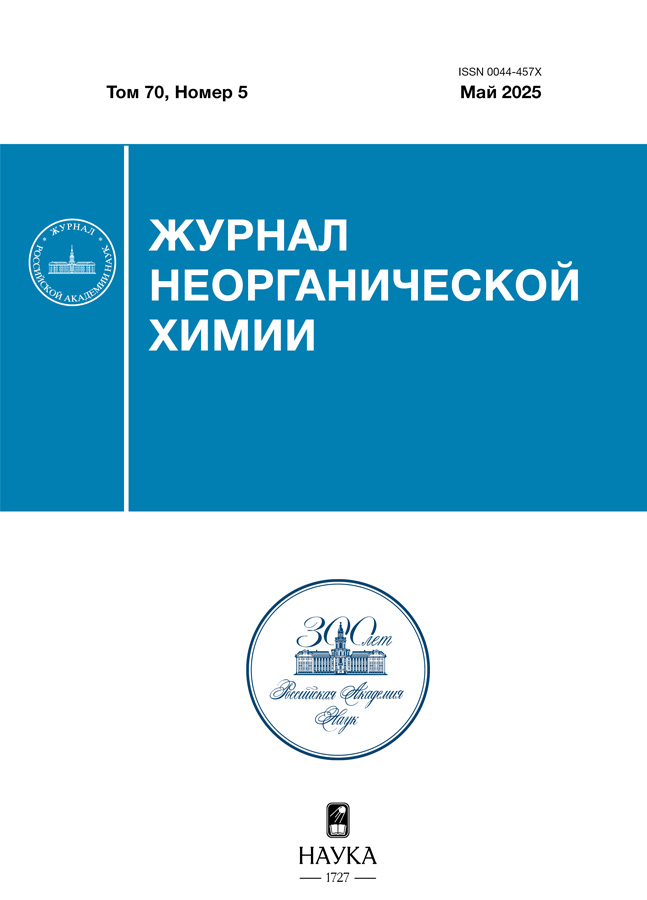Cryoprotectant based on a glass-forming aqueous solution of magnesium acetate
- Authors: Kirilenko I.A.1, Tarakanova E.G.1
-
Affiliations:
- Kurnakov Institute of General and Inorganic Chemistry Russian Academy of Sciences
- Issue: Vol 70, No 5 (2025)
- Pages: 668-677
- Section: СИНТЕЗ И СВОЙСТВА НЕОРГАНИЧЕСКИХ СОЕДИНЕНИЙ
- URL: https://ruspoj.com/0044-457X/article/view/685470
- DOI: https://doi.org/10.31857/S0044457X25050065
- EDN: https://elibrary.ru/HYCWOS
- ID: 685470
Cite item
Abstract
For the first time a cryoprotectant based on glass-forming aqueous solution of magnesium acetate, a metal vital for the human body, was obtained and studied by DSC method. This cryoprotectant – Mg(CH3COO)2 ∙ 12H2O – surpasses the available analogues by the following parameters: it has a high glass-forming ability (it passes from the glassy state to the liquid state without crystallization), is non-toxic and easy to obtain. Its cryoprotective ability, proved on chicken egg white, does not depend on the rate of cooling and heating. It is shown that among glass-forming solutions of Mg(CH3COO)2–H2O system there are five more potential cryoprotectants and preservative for hypothermic storage of biological material. The molecular mechanism preventing damage and death of biological material placed in solutions of the Mg(CH3COO)2–H2O system favourable for cryopreservation has been established using the density functional theory method.
Full Text
About the authors
I. A. Kirilenko
Kurnakov Institute of General and Inorganic Chemistry Russian Academy of Sciences
Author for correspondence.
Email: iakirilenko@mail.ru
Russian Federation, Leninskii prosp. 31, Moscow, 119991
E. G. Tarakanova
Kurnakov Institute of General and Inorganic Chemistry Russian Academy of Sciences
Email: iakirilenko@mail.ru
Russian Federation, Leninskii prosp. 31, Moscow, 119991
References
- Warner R.M., Brown K.S., Benson J.D. et. al. // Cryobiology. 2022. V. 108. P. 1. https://doi.org/10.1016/j.cryobiol.2022.09.002
- Best B.P. // Rejuvenation Research. 2015. V. 18. № 5. P. 422. https://doi.org/10.1089/rej.2014.1656
- Kostyaev A.A., Martusevich A.K., Andreev A.A. // Nauchnoe Obozrenie. Meditsinskie Nauki. 2016. № 6. P. 54. https://science-medicine.ru/en/article/view?id=944
- Morris J., Acton E. // Cryobiology. 2013. V. 66. P. 85. https://doi.org/10.1016/j.cryobiol.2012.11.007
- Elliott G.D., Wang S., Fuller B.J. // Cryobiology. 2017. V. 76. P. 74. https://doi.org/10.1016/j. cryobiol.2017.04.004
- Zinchenko A.V., Bobrova E.N. // Dopovidi Natsional'noi Akademii Nauk Ukraini. 2010. № 12. P. 166.
- Osei-Bempong C., Ghareeb A.E., Lako M. et. al. // Cryobiology. 2018. V. 84. P. 98. 10.1016/j.cryobiol.2018.07.008' target='_blank'>https://doi: 10.1016/j.cryobiol.2018.07.008
- Luyet B.J., Gehenio P.M. Life and death at low temperatures / Normandy: Biodinamica. 1940.
- Polge C., Smith A.U., Parkes A.S. // Nature. 1949. V. 164. № 10. P. 666. https://doi.org/10.1038/164666a0
- Rasmussen D.H., Mackenzie A.P. // Nature. 1968. V. 220. № 12. P. 1315. https://doi.org/10.1038/2201315a0
- Кириленко И.А. Водно-электролитные стеклообразующие системы / М.: Красанд, 2016.
- Hagg G.I. // J. Chem. Phys. 1935. № 3. P. 42. https://doi.org/10.1063/1.1749624
- Кобеко П.П. Аморфные вещества: Физико-химические свойства простых и высокомолекулярных аморфных тел. М. – Л.: изд-во АН СССР. 1952.
- Rawson H. Inorganic Glass-forming Systems / London N-Y: Acad. Press. 1967.
- Tammann. G. Der Glaszustand. Leipzig: Verlag Leop. Voss. 1933. https://doi.org/10.1002/ange.19330463312
- Аппен А.А. Химия стекла / Л.: Химия. 1974. С. 352.
- Дембовский С.А., Чечеткина Е.А. Стеклообразование / М.: Наука. 1990. С. 277.
- Kirilenko I.A., Tarakanova E.G., Mayorov A.V. et. al. // J. Non-Crystal. Solids. 2022. V. 594. 121825. https://doi.org/10.1016/j.jnoncrysol.2022.121825.
- Tarakanova E.G., Kirilenko I.A. // J. Non-Crystal. Solids. 2021. V. 573. 121130. https://doi.org/10.1016/j.jnoncrysol.2021.121130
- Майоров В.Д., Тараканова Е.Г., Майоров А.В., Кислина И.С. // Журн. структур. химии. 2022. Т. 63. № 10. 99312. https://doi.org/10.26902/JSC_id99312
- Tarakanova E.G., Yukhnevich G.V., Kislina I.S., Maiorov V.D. // Phys. Wave Phenom. 2020. V. 28. № 2. P. 168. https://doi.org/10.3103/S1541308X2002017X
- Kirilenko I.A. // Russ. J. Inorg. Chem. 2017. V. 62 № 14. P. 1819. https://doi.org/10.1134/S0036023617140042
- Кириленко И.А., Демина Л.И., Данилов В.П. // Журн. неорган. химии. 2019. Т. 64. № 10. С. 1089. https://doi.org/10.1134/S0044457X19100076
- Kirilenko I.A. // Russ. J. Inorg. Chem. 2018. V. 63. № 13. P. 1728. https://doi.org/10.1134/S0036023618130053
- Кириленко И.А., Демина Л.И. // Журн. неорган. химии. 2018. Т. 63. № 10. С. 1349. https://doi.org/10.1134/S0044457X18100100
- Панасюк Г.П., Лященко А.К., Азарова Л.А. и др. // Журн. неорган. химии. 2018. Т. 63. № 6. С. 796. https://doi.org/10.7868/S0044457X18060211
- Angell C.A., Sare E.J. // J. Chem. Phys. 1970. V. 52. № 3. P. 1058. https://doi.org/10.1063/1.1673099
- Angell С.A., Bressel R.D. // J. Phys. Chem. 1972. V. 76. № 22. P. 3244. https://doi.org/10.1021/j100666a023
- Angell C.A., Tucker J.C. // J. Phys. Chem. 1980. V. 84. № 3. P. 268. https://doi.org/10.1021/j100440a009
- Angell C.A. // Chem. Rev. 2002. V. 102. № 8. P. 2627. https://doi.org/10.1021/cr000689q
- Hodge I.M., Angell C.A. // J. Non-Crystal. Solids. 1976. V. 20. № 2. P. 299. https://doi.org/10.1016/0022-3093(76)90138-1
- Кириленко И.А., Демина Л.И., Данилов В.П. // Журн. неорган. химии. 2022. V. 67. № 11. С. 1554. https://doi.org/10.31857/S0044457X2270012X
- Кириленко И.А., Винокуров А.А., Данилов В.П. и др. // Журн. неорган. химии. 2020. Т. 65. № 7. С. 903. https://doi.org/10.31857/S0044457X20060082
- Saito K., Kinoshita Y., Kanno H. // Fertil. Steril. 1996. V. 65. № 6. P. 1210.
- Abeyrathne N.S., Lee H.Y., Ahn D.U. // Poultry Science 2013. V. 92. № 12. P. 3292.
- Frisch M.J., Trucks G.W., Schlegel H.B. et. al. Gaussian 09. Revision A.02 / Gaussian, Inc. Wallingford CT. 2009.
- Frisch M.J., Trucks G.W., Schlegel H.B. et. al. Gaussian 16, Revision С.01 / Gaussian, Inc., Wallingford CT. 2019.
- Silverstein K.A.T., Haymet A.D.J., Dill K.A. // J. Am. Chem. Soc. 2000. V. 122. № 33. P. 8037. https://doi.org/10.1021/ja000459t
- Бизунок С.Н., Свентицкий Е.Н. Вода в биологических системах и их компонентах / Л.: Изд-во ЛГУ. 1983.
- Жмакин А.И. // Успехи физ. наук. 2008. Т. 178. № 3. С. 243. https://doi.org/10.3367/UFNr.0178.200803b.0243
- Zhmakin A.I. Fundamentals of cryobiology / Berlin, Heidelberg: Springer-Verlag. 2009.
- Levy Y., Onuchic J.N. // Annual Rev. Biophys. 2006. V. 35. P. 389. https://doi.org/10.1146/annurev.biophys.35.040405.102134
- Mazur P. // Science. 1970. V. 168. № 3934. P. 939. https://doi.org/10.1126/science.168.3934.939
Supplementary files















